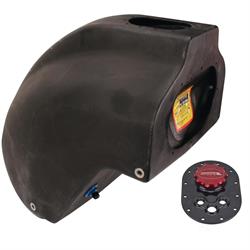Winterizing Your Fuel System
Do you take any precautionary measures to ensure your fuel system is protected throughout the off season? Here are a few things to think about, along with some helpful tips for winterizing your fuel system.
First and foremost, drain all fuel out of the fuel cell and fuel lines. Make sure to store the remaining fuel in your fuel jugs, or designated containers for racing fuel. You will then disconnect all fuel lines and blow them out with compressed air. It is important to do this thoroughly to ensure all lines are dry and free of contaminants. Lastly, store all lines in a safe place so they are ready for the following season.
Follow the same process with fuel filters. Disconnect all filters from the fuel system and disassemble them. Once they are apart, use compressed air to blow all contaminants out of each filtration element. Once the elements are clean, re assemble each filter and store them in a safe place until you are ready to reinstall for the next season.
Next, uninstall the fuel pump. Continuing with nearly the same process, use compressed air to dry the fuel pump and ensure you free the pump of all contaminants. Once you have done a thorough job, you will need to lubricate the pump prior to storage. Whether you use a mechanical pump or an electric pump, you should lubricate them internally to keep all moving internal parts free and protect them from seizing.
Most open wheel race cars use a mechanical pump while electric pumps, such as the Walbro Inline Pump, part #960392, are commonly used on micro and lightning sprints. Several drops of Marvel Mystery Oil or something similar will work best. On mechanical pumps, use a wrench to turn the input shaft so that you can rotate the internal parts and ensure everything gets lubricated.
Prior to the start of a new season, it is crucial to drain and clean your fuel cell bladder. Methanol is inherently corrosive and will leave buildup behind. If left unattended over the course of the off season, you may run the risk of contaminating your fuel when pouring it back into your cell. This will jeopardize your fuel systems ability to work properly and/or efficiently, which will also decrease performance.
Uninstall your fuel cell, disassemble, and remove bladder from the shell. Prior to reassembly, wash the inside of bladder thoroughly with dish soap and hot water. Make sure you scrub well and rinse out several times to ensure the bladder is clean and free of all impurities/contaminants. Let the bladder dry for a day or two before putting the bladder back into the shell. It works best to suspend the bladder upside down so excessive water can drain out.
You will then need to reassemble the fuel cell and store in a safe place until you are ready to reinstall your fuel cell for the next season. Make this part of your annual winterizing routine to be proactive and ready for the upcoming seasons.
Speedway has plenty of replacement parts for fuel cells such as replacement shells like the 25 Gallon OS 25 Sprint Fuel Tank Shell, part #94053600. Or replacement bladders like the 25 Gallon SBI Fuel Systems SB 125-T Sprint Fuel Tank Bladder, part #94053601. We carry many different brands of fuel cells and various parts to fit all sizes of open wheel cars. A common seller for micro sprint customers is our 8 Gallon Outlaw Tank, part #960214. Browse our vast inventory at Speedway Motors online or give us a call today for assistance with you fuel system parts!



